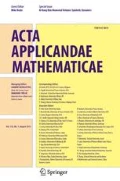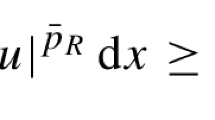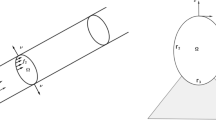Abstract
We prove existence and uniqueness of minimizers for a family of energy functionals that arises in Elasticity and involves polyconvex integrands over a certain subset of displacement maps. This work extends previous results by Awi and Gangbo to a larger class of integrands. We are interested in Lagrangians of the form \(L(A,u)=f(A)+H(\det A)-F\cdot u \). Here the strict convexity condition on \(f \) and \(H \) have been relaxed to a convexity condition. Meanwhile, we have allowed the map \(F \) to be non-degenerate. First, we study these variational problems over displacements for which the determinant is positive. Second, we consider a limit case in which the functionals are degenerate. In that case, the set of admissible displacements reduces to that of incompressible displacements which are measure preserving maps. Finally, we establish that the minimizer over the set of incompressible maps may be obtained as a limit of minimizers corresponding to a sequence of minimization problems over general displacements provided we have enough regularity on the dual problems. We point out that these results do not rely on the direct methods of the calculus of variations.
Similar content being viewed by others
References
Ambrosio, L., Gigli, N., Savaré, G.: Gradient Flows: In Metric Spaces and in the Space of Probability Measures. Lectures in Mathematics. Birkhäuser, Basel (2005)
Awi, R., Gangbo, W.: A polyconvex integrand; Euler–Lagrange equations and uniqueness of equilibrium. Arch. Ration. Mech. Anal. 214(1), 143–182 (2014)
Brenier, Y.: Polar factorization and monotone rearrangement of vector-valued functions. Commun. Pure Appl. Math. 44, 375–417 (1991)
Dacorogna, B.: Direct Methods in the Calculus of Variations. Springer, Berlin (2008)
Evans, L.C.: Monotonicity formulae for variational problems. Philos. Trans. R. Soc., Math. Phys. Eng. Sci. 371(2005), 20120339 (2013)
Evans, L.C., Gariepy, R.: Measure Theory and Fine Properties of Functions. CRC Press, Boca Raton (1992)
Evans, L.C., Savin, O., Gangbo, W.,: Diffeomorphisms and nonlinear heat flows. SIAM J. Math. Anal. 37(5), 737–751 (2005)
Gangbo, W.: An elementary proof of the polar factorization of vector-valued functions. Arch. Ration. Mech. Anal. 128, 381–399 (1994)
Gangbo, W.: The Monge mass transfer problems and its applications. In: NSF-CBMS Conference. Contemporary Mathematics (1999)
Gangbo, W., McCann, R.J.: The geometry of optimal transportation. Acta Math. 177(2), 113–161 (1996)
Gangbo, W., Van Der Putten, R.: Uniqueness of equilibrium configurations in solid crystals. SIAM J. Math. Anal. 32(3), 465–492 (2000)
Gangbo, W., Westdickenberg, M.: Optimal transport for the system of isentropic Euler equations. Commun. Partial Differ. Equ. 34, 1041–1073 (2009)
Rockafellar, R.T.: Convex Analysis. Princeton Univ. Press, Princeton (1970)
Rockafellar, R.T., Wets, M., Wets, R.J.B.: Variational Analysis. Grundlehren der mathematischen Wissenschaften (2009)
Villani, C.: Topics in Optimal Transportation. Graduate Studies in Mathematics Series. Am. Math. Soc., Providence (2003)
Author information
Authors and Affiliations
Corresponding author
Additional information
Publisher’s Note
Springer Nature remains neutral with regard to jurisdictional claims in published maps and institutional affiliations.
Most of the work presented in this paper was carried out while R.A. was a postdoctoral fellow at the Institute for Mathematics and its Applications during the IMA’s annual program on Control Theory and its Applications.
M.S. gratefully acknowledges the support of the King Abdullah University of Science and Technology.
Appendix
Appendix
1.1 A.1 Proof of Lemma 3.4
We will prove Lemma 3.4 through two lemmas. The results of the first lemma can be found in Lemma 4.3 of [2]. We give here a sketch of the proof for the convenience of the reader.
Lemma A.1
Assume that\(\mathbf{(A2)}\)holds. Consider a lower semicontinuous function\(l:\mathbb{R}^{d} \to \bar{\mathbb{R}} \)such that\(\inf_{\bar{\varLambda }}l>-\infty \); \(l\)is finite on\(\varLambda \)and\(l \equiv +\infty \)on\(\mathbb{R}^{d} \setminus \bar{\varLambda }\). Set\(k= l^{\#}\)and let\(w\in \mathbb{R}^{d} \). Then:
-
1.
There exist\(\bar{u}\in \bar{\varLambda }\)and\(\bar{t}>0\)such that
$$ k( w ) =-\bar{t}l(\bar{u})-H(\bar{t})-\bar{u}\cdot w. $$(A.1)Moreover, \(\bar{u} \)and\(\bar{t} \)satisfy\(\bar{u}\in \partial k( w) \)and\(H'(\bar{t})+l(\bar{u})=0\).
-
2.
If\(k\)is differentiable at\(w\)then\(\bar{u}\)and\(\bar{t}\)are uniquely determined by\(\bar{u}=\nabla k(w)\)and\(\bar{t}=(H')^{-1}(-l( \bar{u}))\).
Proof
(1.) We have
Consider a maximizing sequence \(\{(u_{n},t_{n})\}_{n=1}^{\infty } \) in (A.2). As \(0\in \varLambda \), we may assume without loss of generality that
for \(n\geq 1\). It follows that
for \(n\geq 1\). In light of the growth condition on \(H \) in (A2) there exists a positive real number \(\alpha \) such that \(\{t_{n}\}_{n=1}^{\infty }\subset [\alpha ,\alpha ^{-1}] \). As \(\varLambda \) is bounded, we may assume without loss of generality that the sequence \(\{(u_{n},t_{n})\}_{n=1}^{\infty }\) converges to some \((\bar{u},\bar{t})\in \bar{\varLambda }\times [\alpha ,\alpha ^{-1}] \). We next use the lower semicontinuity of \(H \) and \(l \) to deduce that
Note that \(k(w)\geq \bar{u}\cdot w-l(\bar{u})t-H( t) \text{ for all }t>0\). In view of (A.3), it follows that \(g: (0, \infty )\to \mathbb{R}\) defined by \(g(t)=\bar{u}\cdot w-l(\bar{u})t-H( t) \) admits a maximum at \(\bar{t} \). As \(g\) is differentiable at \(\bar{t}\), we have \(g'(\bar{t})=0 \), that is, \(l(\bar{u})+H'( \bar{t})=0 \). Next, observe that \(k(z)\geq \bar{u}\cdot z-l(\bar{u}) \bar{t}-H( \bar{t}) \text{ for all }z\in \mathbb{R} ^{d}\). In light of the convexity of \(k\) we have that \(\bar{u}\in \partial k(w) \).
(2.) Assume that \(k\) is differentiable at \(w\). Then, \(\bar{u}\) is uniquely determined as \(\bar{u}=\nabla k (w) \). As \(H'(\bar{t})=-l_{0}(\bar{u}) \) and \(H' \) is a bijection, we obtain that \(\bar{t} \) is also uniquely determined as \(\bar{t}=(H')^{-1}(-l(\bar{u}))\). □
The second lemma which is inspired by Lemma 4.4 in [2] is the following:
Lemma A.2
Assume that\(\mathbf{(A2)}\)holds. Consider a lower semicontinuous function\(l_{0}:\mathbb{R}^{d} \to \bar{\mathbb{R}} \)such that\(\inf_{\bar{\varLambda }}l_{0}>-\infty \); \(l_{0}\)is finite on\(\varLambda \)and\(l_{0}\equiv +\infty \)on\(\mathbb{R}^{d} \setminus \bar{ \varLambda }\). Set\(k_{0}= ({l_{0}})^{\#}\). Let\(\hat{l}\in C_{b}( \mathbb{R}^{d} )\)and let\(1\geq \epsilon >0\). Define\(l_{\epsilon }=l _{0}+\epsilon \hat{l}\)and\(k_{\epsilon }={ (l_{\epsilon } )} ^{\#}\). Let\(v\in \mathbb{R}^{d} \)be such that\(k_{0}\)is differentiable at\(v\).
-
1.
There exists a constant\(M\)independent of\(v\)and\(\epsilon \)such that
$$ \biggl\vert \frac{k_{\epsilon }(v)-k_{0}( v ) }{\epsilon } \biggr\vert \leq M. $$(A.4) -
2.
We have
$$ \lim_{\epsilon \rightarrow 0 } \frac{k_{\epsilon }(v)-k_{0}( v ) }{ \epsilon }=- t_{0}\hat{l}(u_{0}). $$(A.5)
Proof
Note that the map \(l_{\epsilon }=l_{0}+\epsilon \hat{l} \) is bounded below by \(m-|\hat{l}|_{\infty }\). As \(k_{\epsilon }={ (l _{\epsilon } )}^{\#}\) and \(k_{0}={ (l_{0} )}^{\#}\), Lemma A.1 ensures that there exist \(t_{0}, t_{\epsilon }>0 \) and \(u_{0}, u_{\epsilon }\in \bar{\varLambda }\) such that
and
We then have
and
We combine (A.6) and (A.7) to get
Using again Lemma A.1 we have
As \(l_{\delta }\) is bounded below by \(m-|l|_{\infty }\), we use the fact that \(H' \) is a continuous and strictly increasing bijection from \((0,\infty )\) to ℝ to deduce that \(t_{\delta }\) is bounded above by \(M_{1}>0 \) given by \(M_{1}:=(H')^{-1}(-m+|\hat{l}|_{\infty })\). This bound on \(t_{\delta }\) combined with (A.8) yields a constant \(M:=|\hat{l}|_{\infty }(H')^{-1}(-m+| \hat{l}|_{\infty })\) such that (A.4) holds. As a result \(\lim_{\epsilon \to 0^{+}}k_{\epsilon }(v)=k_{0}(v)\). Next, let \(\{e_{n}\}_{n=1}^{\infty }\subset (0,1] \) converging to 0 such that \(\limsup_{\epsilon \to 0} \hat{l}(u_{\epsilon })t_{\epsilon }= \lim_{n\to \infty }\hat{l}(u _{e_{n}} )t_{e_{n}}\). Without loss of generality, we may assume that \(\{u _{e_{n}}\}_{n=1}^{\infty } \) converges to some \(\bar{u}\in \bar{\varLambda }\) and \(\{ t _{e_{n}}\} _{n=1}^{\infty } \) converges to \(\bar{t} \in [0,M_{1}]\). Exploiting the lower semicontinuity of \(l_{0} \), \(\hat{l} \) and \(H \), we get:
It follows that \(k_{0}(v)=\bar{u} v-l_{0}(\bar{u})\bar{t}-H(\bar{t}) \). As \(k_{0}\) is differentiable at \(v\), we have \(t_{0}=\bar{t} \) and \(u_{0}=\bar{u} \). We use (A.8), the definition of \(\{e_{n}\}_{n=1}^{\infty }\), the convergence of \(\{u _{e_{n}}\}_{n=1} ^{\infty } \) and \(\{ t _{e_{n}}\}_{n=1}^{\infty } \) to obtain
As a result, \(\lim_{\epsilon \to 0}-t_{\epsilon }\hat{l}(u_{\epsilon })=-t_{0}\hat{l}(u_{0}) \). We invoke one more time Eq. (A.8) to obtain (A.5). □
1.2 A.2 Some Properties of the Legendre Transform
We have the following lemma which is similar to Lemma 3.4 but uses the Legendre transform instead of the \((\cdot )^{\#}\) operator.
Lemma A.3
Consider a lower semicontinuous function\(l_{0}:\mathbb{R}^{d} \to \bar{ \mathbb{R}} \)such that\(\inf_{\bar{\varLambda }}l_{0}>-\infty \); \(l_{0}\)is finite on\(\varLambda \)and\(l_{0}\equiv +\infty \)on\(\mathbb{R}^{d} \setminus \bar{\varLambda }\). Set\(k_{0}= ({l_{0}})^{*}\).
-
1.
There exists a measurable map\(T_{0}:\mathbb{R}^{d} \to \mathbb{R} ^{d}\)such that\(k_{0}(v)=v\cdot T_{0}(v)-l_{0}(T_{0}(v)) \)for all\(v\in \mathbb{R}^{d} \)and\(T_{0}(v)=\nabla k_{0}(v) \)whenever\(k_{0} \)is differentiable at\(v\in \mathbb{R}^{d} \).
-
2.
Let\(\hat{l}\in C_{b}(\mathbb{R}^{d} )\)and let\(1\geq \epsilon >0\). Define\(l_{\epsilon }=l_{0}+\epsilon \hat{l}\)and\(k_{\epsilon }= { (l_{\epsilon } )^{*}}\).
-
(a)
For all\(v\in \mathbb{R}^{d} \)we have:
$$ \biggl\vert \frac{k_{\epsilon }(v)-k_{0}( v ) }{\epsilon } \biggr\vert \leq | \hat{l}|_{\infty }. $$ -
(b)
For\(\epsilon \in (0,1)\), there exists a map\(T_{\epsilon }: \mathbb{R}^{d} \to \mathbb{R}^{d} \)satisfying for all\(v\in \mathbb{R}^{d} \): \(k_{\epsilon }(v)=vT_{\epsilon }(v)-l_{\epsilon }(T _{\epsilon }(v))\). When\(k_{0} \)is differentiable at\(v\in \mathbb{R}^{d} \), we have\(\lim_{\epsilon \to 0}T_{\epsilon }(v)= \nabla k_{0}(v)\)and
$$ \lim_{\epsilon \rightarrow 0 } \frac{k_{\epsilon }(v)-k_{0}( v ) }{ \epsilon }=- t_{0} \hat{l}\bigl(\nabla k_{0}(v)\bigr). $$
-
(a)
Proof
(1.) Let \(v\in \mathbb{R}^{d} \). We have
We use the lower semicontinuity of \(l_{0} \) and the compactness of \(\bar{\varLambda }\) to deduce that there exists \(\bar{u}\in \varLambda \) such that \(k_{0}(v)=\bar{u} v-l_{0}(\bar{u})\). We have \(k_{0}(w)-( \bar{u}w-l_{0}(\bar{u}))\geq 0 \) for all \(w\in \mathbb{R}^{d} \) while \(k_{0}(v)-(\bar{u}v-l_{0}(\bar{u}))= 0 \). Since \(k_{0} \) is convex, we deduce that \(\bar{u} \in \partial k_{0}(v) \).
Next, for \(v\in \mathbb{R}^{d} \), define
Assume \(\{u_{n}\}_{n\in \mathbb{N}}\subset \mathbb{R}^{d} \) converges to \(u \); \(\{v_{n}\}_{n\in \mathbb{N}}\subset \mathbb{R}^{d} \) converges to \(v \) and for all \(n\in \mathbb{N} \), one has \(u_{n}\in \varGamma (v_{n}) \). Then \(u\in \varGamma (v) \). Indeed, one has
Therefore, \(uv-l_{0}(u)=k_{0}(v) \) and \(u\in \varGamma (v) \). As a result, the multifunction \(\varGamma :\mathbb{R}^{d} \rightrightarrows \mathbb{R}^{d} \) is closed and nonempty valued. By the Measurable Selection Theorem [14, Corollary 14.6], there exists a measurable map \(T_{0}:\mathbb{R}^{d}\to \mathbb{R}^{d} \) such that for all \(v\in \mathbb{R}^{d} \), one has \(T_{0}(v)\in \varGamma (v) \). That is \(k_{0}(v)=vT_{0}(v)-l_{0}(T_{0}(v)) \). As \(T(v)\in \varGamma (v)\subset \partial k_{0}(v) \), we also have \(T_{0}=\nabla k_{0} \) almost everywhere.
(2.) For \(\epsilon >0 \), \(l_{\epsilon }\) is bounded below and satisfies the hypothesis on \(l_{0} \). Let \(k_{\epsilon }=l_{\epsilon }^{*} \) and consider a map \(T_{\epsilon }\) satisfying for all \(v\in \mathbb{R} ^{d} \): \(k_{\epsilon }(v)=vT_{\epsilon }(v)-l_{\epsilon }(T_{\epsilon }(v))\) as given by part 1.). We have for \(v\in \mathbb{R}^{d} \):
Similarly, for \(v\in \mathbb{R}^{d} \) we have
We combine (A.10) and (A.11) to get
which leads to
Consider a sequence \(\{\epsilon _{n}\}_{n} \) converging to 0. The sequence \(\{T_{\epsilon _{n}}(v)\}_{n} \) is bounded so we may find a subsequence \(\{\epsilon '_{n}\}_{n} \) of \(\{\epsilon _{n}\}_{n} \) such that the sequence \(\{T_{\epsilon '_{n}}(v)\}_{n} \) converges to \(u\in \bar{\varLambda }\). We then have:
We use (A.14) to obtain \(k_{0}(v)=vu-l_{0}(u)\) and thus \(u=\nabla k_{0}(v) \) as \(k_{0} \) is differentiable at \(v \). It follows that \(\lim_{\epsilon \to 0}T_{\epsilon }(v)= \nabla k_{0}(v)\). We use Eq. (A.12) and the continuity of \(\hat{l} \) to obtain
□
Rights and permissions
About this article
Cite this article
Awi, R., Sedjro, M. On the Uniqueness of Minimizers for a Class of Variational Problems with Polyconvex Integrand. Acta Appl Math 168, 137–167 (2020). https://doi.org/10.1007/s10440-019-00282-0
Received:
Accepted:
Published:
Issue Date:
DOI: https://doi.org/10.1007/s10440-019-00282-0




